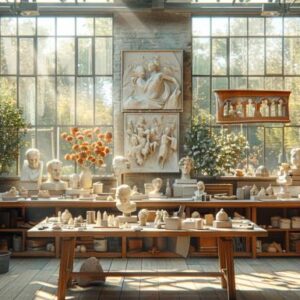Ever wondered why works of art have such a sacred place in the tapestry of our culture? In our guide “A Brief History of Art: A Beginner's Guide”, I invite you to embark on a journey that weaves through centuries of creativity and human expression. Discover how, by unraveling the history of art, we tap directly into the pulse of the social and cultural contexts that shaped our civilizations. From the majestic Sistine to the vibrant colors of Guernica, each brushstroke tells a story that reverberates into our contemporary times. Come and discover these precious legacies with me and understand the fundamental role that art plays in the current scenario.
How important is it to understand the history of art and its significant works?
Understanding the history of art is essential to understanding the cultural and social context of various eras. This understanding provides insights into the beliefs, dilemmas, and values of past and present societies. The cultural impact of the arts in contemporary times is significant, because through them, we can see how historical conceptions still influence our world.
Iconic works of art shape society by reflecting and questioning cultural, political and personal issues. For example, the Mona Lisa, with her enigmatic smile, is not just a painting; it is a symbol that has survived time, still intriguing and inspiring debates and interpretations today. As we become familiar with the art history explained, we gain a powerful tool to decode these influences and appropriate a cultural legacy full of meanings and learning.
What are the main artistic movements and their characteristics?
The Renaissance and Baroque movements were fundamental in the evolution of visual arts. The Renaissance, marked by a return to classical learning, brought technical advances in realism and perspective, with renowned artists such as Leonardo da Vinci and Michelangelo. Baroque was distinguished by its drama and richness of colors, creating an aesthetic of grandeur and emotion.
The distinction between modernism and postmodernism in art is mainly due to the approach and concepts used. Modernism is characterized by the search for innovation, rupture with the past and abstraction, with movements such as Expressionism, Cubism and Surrealism. In contrast, postmodernism focuses on deconstructing these previous narratives, presenting a skepticism about “big stories” and valuing diversity and contextualization.
These important movements and their artistic styles are just a few examples of the rich tapestry that makes up art history. Learn about these characteristics It allows us to appreciate the works more deeply and understand the reflection of society in each historical period.
Who are the renowned artists and what are their most striking works?
Leonardo da Vinci profoundly impacted world art with famous works such as the “Mona Lisa” and “The Last Supper”. His works are known for their innovative use of perspective and detailed study of human anatomy; a true fusion of art and science that characterized the Renaissance. Michelangelo, another giant of this period, is revered for his “David” and “Pietà” sculptures, as well as the monumental painting of the Sistine Chapel.
In the 20th century, Picasso transformed visual art with Cubism, challenging traditional notions of form and space in paintings such as “Les Demoiselles d'Avignon”. Dalí, master of Surrealism, provoked with his dreamlike and extraordinary images, of which “The Persistence of Memory” is exemplary.
These artists are more than creators; They are geniuses whose legacy goes beyond the limits of time and continues to influence contemporary art, revolutionizing artistic perception and expanding the boundaries of creativity.
How to interpret and appreciate a work of art?
What are the analysis techniques to understand a work of art? The technique of formal analysis is key to understanding a work of art, it consists of observing visual elements such as color, line, shape, texture and composition. The historical context and cultural influences of the time in which the work was created are also considered.
The impact of personal perception on art appreciation is immeasurable. Each individual brings their experiences and knowledge to the table, which enriches the experience by allowing different interpretations and emotional connections with the work. When investigating the analyzes of famous paintings and explore historical influences on art, we uncover layers of meaning that connect us more deeply with the humanism intrinsic to all artistic expression.
Through this immersion, we discover that art is not just a reflection of life; it is a bridge to understanding the complexity of the human spirit. By delving deeper into the narratives and symbolisms that permeate great works, we are, in fact, exploring the most intimate corners of our own existence.
What is the relationship between technological evolution and the visual arts?
The invention of photography had a decisive impact on the visual arts, changing the way artists saw and captured reality. Until then, painting and drawing were the main ways of visually recording people, landscapes and events. With photography, a new way of seeing emerges, more immediate and realistic, provoking artists to seek new languages and aesthetics, leading to modern art.
New digital media, in turn, continue to reshape art. Through them, art has become more accessible and democratic, with creations ranging from digital illustrations to immersive installations provoking reflections on the future of human expression on the threshold of virtual reality.
Classical art and modern art are therefore connected and differentiated by these technological developments. Classical art emphasized traditional techniques and realistic representations, while modern art is often characterized by experimentation and abstraction, exploring new mediums and concepts influenced by technological advancement.
How does art education influence people’s intellectual and cultural development?
The importance of teaching art history in schools and cultural institutions is fundamental to training individuals with critical thinking and aesthetic sensitivity. The study of art helps reveal the complexities of human thought and the evolution of our societies over time. Furthermore, artistic education instigates human development, as it stimulates cognitive and emotional aspects of students, promoting creativity and individual expression.
When citizens gain knowledge about art, they tend to become more aware of their own and others' cultures, resulting in a more diverse and creative society. Art offers different perspectives and ways of seeing the world, enabling a richer understanding of the human condition. By exploring the notable works and movements that have shaped art history, people of all ages can learn to value and interpret the cultural legacy left by past generations, as well as produce new artistic expressions that reflect the challenges and aspirations of their own. time.
Who are the renowned artists and what are their most striking works?
Leonardo da Vinci and Michelangelo profoundly impacted world art with their creations. Both are icons of the Renaissance, an artistic movement that emphasized humanism, science and the rediscovery of classical values. Their legacy transcends centuries, but what makes their works so remarkable and revolutionary?
Leonardo da Vinci's paintings and sculptures, such as the “Mona Lisa” and “The Last Supper”, are celebrated worldwide for their technical perfection and enigmatic expression. Michelangelo, with his Sistine Chapel frescoes and “David” statue, is remembered for his powerful depictions and precise anatomy. These works not only define the contours of Renaissance art but also shape our understanding of human capacity and beauty.
In the 20th century, artists such as Picasso and Dalí challenged artistic perception by creating new ways of visualizing the world. Cubism, introduced by Picasso, broke with the traditional representation of perspective, while Dalí's Surrealism brought the bizarre and dreamlike to the screen. These artists deeply explored the human psyche, creating works that allow multiple interpretations and continuous reflections.
Understand and appreciate the contribution of these art geniuses it is understanding human history and the capacity for innovation and expression that is inherent in us. By observing his most striking works, we realize how art can transform our perception of what is possible.
In this immersion in the history of art, we navigate from the cultural and social contexts that shaped different eras to the nuances of the artistic movements that defined the visual panorama of their times. We recognize the genius impact of names like Leonardo da Vinci and Michelangelo and how modern and postmodern artists like Picasso and Dalí broadened our perceptual horizons. We also evaluate the importance of technology in artistic development and the vital role of artistic education in building a more conscious society. By reflecting on each brushstroke of the past, we discover not only the beauty of great works, but also the mirror of humanity they represent. This knowledge not only enriches our artistic appreciation but also illuminates the creative and intellectual paths of the present and the future.
Frequently Asked Questions (FAQ)
1. How can art history contribute to the understanding of society?
Art history offers valuable insights into the beliefs, values and dilemmas of societies over time, helping to decipher the culture and social context of different eras. Art acts as a reflection of humanity and its evolution, revealing how historical conceptions continue to influence our present day.
2. What are the distinct characteristics of the Renaissance and Baroque movements?
The Renaissance movement was notable for its return to classical learning and advances in realism and perspective, while the Baroque was known for its drama and rich colors, expressing grandeur and emotion. These styles have had a significant impact on the evolution of visual arts and the way we perceive and value art.
3. Who were some of the most influential artists and their key works?
Leonardo da Vinci and Michelangelo are renowned Renaissance artists, important for their works such as “Mona Lisa” and “David”. In the 20th century, Picasso and Dalí revolutionized visual art with movements such as Cubism and Surrealism, challenging traditional concepts and bringing new perspectives through works such as “Les Demoiselles d'Avignon” and “The Persistence of Memory”.
4. Why is it essential to understand the techniques for interpreting a work of art?
Understanding formal analysis techniques, such as observing visual elements and the historical-cultural context, is essential for a deep interpretation of a work of art. Such understanding enriches personal experience and allows access to different layers of meaning in works, promoting a more intimate connection with artistic expression and the human spirit.
5. What is the impact of technology on the evolution of visual arts?
Technology has radically transformed the visual arts, from the invention of photography to the digital age, challenging artists to find new forms of expression and making art more accessible. Technological evolution has expanded the limits of creativity, influencing both the production and perception of art in different historical phases.







